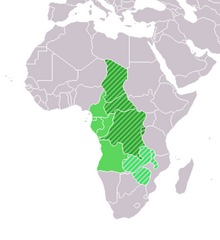
Central Africa marked in green.
Recent archaeological expeditions discovered a cave that contained thirteen skulls on the banks of the Upper Semliki River, in Katanda, Central Africa. All had been crushed. Near them was a large pile of fossilized ash. Laboratory analysis determined the ash to be the remains of thirteen Homo sapiens.
On the wall of the cave is a painting of a human figure, hands raised in a threatening posture, eyes fixed in an evil gaze. Inside its gaping mouth is the body of another human. This find has not been accepted as a genuine zombie incident. One school of thought argues that the crushed skulls and burned bodies were a means of ghoul disposal, while the cave drawing serves as a warning; other academics demand some type of physical evidence, such as a trace of fossilized Solanum. Results are still pending.
If Katanda's authenticity is confirmed, it raises the question of why there was such a large gap between this first outbreak and the one that followed.This also could refer to cannibalism in these times.
See also
| The Zombie Survival Guide: Complete Protection From the Living Dead | |
| Max Brooks | Solanum | Zombies | Outbreaks | Recorded Attacks |
| This article features writing or information released under the Creative Commons Attribution-NonCommercial 3.0 Deed. |
